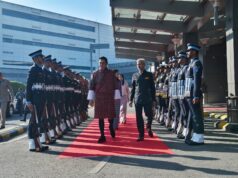As the Digital Silk Road (DSR) marks its tenth anniversary in 2025, a new report by the Center for a New American Security (CNAS) examines how China’s decade-long drive to shape global digital infrastructure has evolved into a central pillar of its geopolitical strategy.
“Countering the Digital Silk Road”, authored by Vivek Chilukuri and Ruby Scanlon of CNAS’s Technology and National Security Program, draws on 18 months of research and over 40 expert interviews across Indonesia, Brazil, Kenya, and Saudi Arabia. The authors credit local insights gathered during field visits to these nations for grounding their analysis in emerging-market realities.
According to CNAS, the Digital Silk Road, launched in 2015 as the technology arm of the Belt and Road Initiative, has become the centrepiece of Beijing’s efforts to expand economic and strategic influence through digital infrastructure. What began as a government-driven policy has now matured into a global technology ecosystem powered by Chinese firms such as Huawei, ZTE, Alibaba, and Tencent. Despite Beijing’s public retreat from the DSR label, the initiative’s objectives have been woven into China’s broader statecraft, enabling it to dominate crucial areas of digital connectivity from telecommunications to artificial intelligence.
The report finds that China’s influence over global digital infrastructure is now both pervasive and understated. By pairing generous state financing with aggressive commercial diplomacy, Beijing has advanced a model of “technology statecraft” that often gives Chinese vendors a decisive edge in price, speed, and integration. Huawei, for instance, now operates in over 170 countries and leads the global telecommunications equipment market.
The authors argue that countering the DSR is not about rejecting all Chinese technology, but about addressing where its spread threatens U.S. interests and democratic values.
The case rests on four key concerns: the erosion of U.S. and allied market share in fast-growing digital markets; mounting cybersecurity and surveillance risks; Beijing’s growing control over next-generation technologies such as 5G, AI, and low-Earth orbit satellites; and the export of techno-authoritarian systems that erode democratic governance.
Chilukuri and Scanlon highlight how Beijing’s approach combines industrial policy, concessional financing, bundled services, and diplomatic leverage. China Exim Bank and the China Development Bank have extended billions in tied loans for projects that mandate the use of Chinese technology and services, a model the authors describe as an “Iron Triangle”.
The CNAS report identifies six key technology arenas where the U.S. and its allies are competing with China: subsea cables, next-generation telecommunications, low-Earth orbit satellites, data centres and cloud services, artificial intelligence, and smart cities. Each domain represents an essential component of the world’s digital foundation, where control over infrastructure translates directly into long-term strategic influence.
Chinese dominance in telecom equipment gives Beijing sustained leverage over countries’ communications systems, while its expanding smart city programmes and surveillance networks across Africa and Latin America have raised global concerns about data integrity and privacy.
The study turns a critical eye on Washington’s response, concluding that while awareness has grown, strategy and resources remain lacking. Despite initiatives such as the Partnership for Global Infrastructure and Investment (PGI) and the Quad’s Indo-Pacific digital programmes, CNAS finds that “ambitious rhetoric has outstripped committed resources.” Washington, the authors argue, has focused more on restricting Chinese technologies than on offering credible, competitive alternatives.
New efforts such as the State Department’s Bureau of Cyberspace and Digital Policy and the International Technology Security and Innovation Fund (ITSI) are significant, but their budgets and coordination mechanisms fall short. Successes, such as U.S. support for Costa Rica in replacing Huawei-built networks, remain the exception rather than the rule. Similar challenges face allied initiatives, including the European Union’s Global Gateway, Japan’s Official Development Assistance, and Australia’s cyber diplomacy, all of which have advanced parallel but uncoordinated agendas.
To address these gaps, Chilukuri and Scanlon urge the United States to adopt a coherent Global Technology Competition Strategy led by the State Department. The report calls for the creation of a Strategic Competition Council to align interagency efforts, consolidate and expand development and export finance institutions under a new U.S. Partnership Agency, and direct greater investment toward digital infrastructure in key emerging markets.
It also recommends quadrupling the U.S. International Development Finance Corporation’s lending capacity to $240 billion, expanding the Countering PRC Influence Fund to at least $1 billion, and updating Export-Import Bank policies to prioritise advanced technology exports.
Beyond funding, the CNAS study emphasises the need for a modernised diplomacy framework. This includes appointing ambassadors with technology expertise, deploying foreign technology officers to critical posts, and leveraging NATO member-state investment funds to build resilient digital ecosystems abroad. The authors also advocate for new strategic technology partnerships that allow foreign governments to align with the United States under shared principles of transparency, security, and trust.
The report further underscores the importance of setting global technology standards. By actively engaging in international standards bodies and shaping regulations in artificial intelligence, cybersecurity, and data governance, Washington and its allies can ensure that democratic values, not authoritarian controls, define the next phase of the digital world.
Chilukuri and Scanlon conclude that the experience of the 5G race offers a cautionary lesson: market forces alone cannot ensure U.S. and allied competitiveness. The United States, they argue, must not mimic Beijing’s state-driven model, but instead adopt “ambitious statecraft fit for an era of global technology competition”.
While acknowledging recent reforms and investments, CNAS warns that without greater resources, coordination, and long-term vision, China’s head start through the Digital Silk Road could become permanent. In their final assessment, the authors describe the DSR as a litmus test for the ability of democracies to act collectively, to compete, to innovate, and to preserve a digital future built on openness, accountability, and shared opportunity.
In a career spanning three decades and counting, Ramananda (Ram to his friends) has been the foreign editor of The Telegraph, Outlook Magazine and the New Indian Express. He helped set up rediff.com’s editorial operations in San Jose and New York, helmed sify.com, and was the founder editor of India.com.
His work has featured in national and international publications like the Al Jazeera Centre for Studies, Global Times and Ashahi Shimbun. But his one constant over all these years, he says, has been the attempt to understand rising India’s place in the world.
He can rustle up a mean salad, his oil-less pepper chicken is to die for, and all it takes is some beer and rhythm and blues to rock his soul.
Talk to him about foreign and strategic affairs, media, South Asia, China, and of course India.





